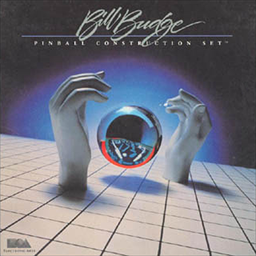
Pinball Construction Set is a video game by Bill Budge written for the Apple II. It was originally published in 1982 through Budge's own company, BudgeCo, then was released by Electronic Arts in 1983 along with ports to the Atari 8-bit computers and Commodore 64.
Educational software is a term used for any computer software that is made for an educational purpose. It encompasses different ranges from language learning software to classroom management software to reference software. The purpose of all this software is to make some part of education more effective and efficient.

Qix is a 1981 puzzle video game developed by husband and wife team Randy and Sandy Pfeiffer and published in arcades by Taito America. Qix is one of a handful of games made by Taito's American division. At the start of each level, the playing field is a large, empty rectangle, containing the Qix, an abstract stick-like entity that performs graceful but unpredictable motions within the confines of the rectangle. The objective is to draw lines that close off parts of the rectangle to fill in a set amount of the playfield.

Underwurlde is a 1984 action-adventure platform video game in the Sabreman series by Ultimate Play the Game for the ZX Spectrum and Commodore 64. The player controls the adventurer Sabreman as he jumps between platforms in a castle and its caverns to find an escape past the exit guardians. Underwurlde features about 600 flip screen areas. Unlike other games of its time, Sabreman is not injured when touched by enemies and is instead knocked backwards. Underwurlde is the second game in the series, between Sabre Wulf and Knight Lore, and released shortly before the latter for the ZX Spectrum in late 1984. Another developer, Firebird, ported the game to the Commodore 64 the next year.
Rocky's Boots is an educational logic puzzle game by Warren Robinett and Leslie Grimm, published by The Learning Company in 1982. It was released for the Apple II, CoCo, Commodore 64, IBM PC and the IBM PCjr. It was followed by a more difficult sequel, Robot Odyssey. It won Software of the Year awards from Learning Magazine (1983), Parent's Choice magazine (1983), and Infoworld, and received the Gold Award from the Software Publishers Association. It was one of the first educational software products for personal computers to successfully use an interactive graphical simulation as a learning environment.

Spinnaker Software Corporation was a software company founded in 1982 known primarily for its line of non-curriculum based educational software, which was a major seller during the 1980s. It was founded by chairman Bill Bowman and president C. David Seuss.

Below the Root is a 1984 video game developed for Commodore 64, IBM PC, and Apple II home computer lines. The game is a continuation of the author Zilpha Keatley Snyder's Green Sky Trilogy, making it the fourth story in the series. The game is set in a fantasy world of Green-Sky covered with enormous trees and wildlife. The player is tasked to choose one of the five characters to explore the world and discover the meaning of the words that appeared in the dreams of the character D'ol Falla. The player explores the world through platforming, solving puzzles and exploration.

Basic Math is an educational video game for the Atari Video Computer System. The game was developed at Atari, Inc. by Gary Palmer. The game involves a series of ten arithmetic problems involving addition, subtraction, multiplication, or division. The player can edit different gameplay modes to alter how the numbers in the problem are chosen, or if their questions are timed. The game was released in 1977 as one of the earliest releases for the console.
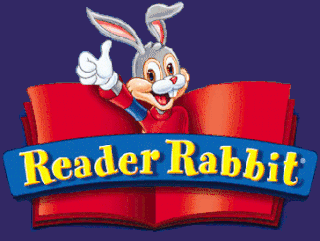
Reader Rabbit is an educational video game franchise created in 1984 by The Learning Company. The series is aimed at children from infancy to the age of nine. In 1998, a spiritual successor series called The ClueFinders was released for older students aged seven to twelve.

Computist was a magazine devoted to the Apple II personal computer that was published by Charles R. Haight under the SoftKey Publishing name, between 1981 and 1993, for a total of 89 issues. The magazine was based in Tacoma, Washington. Originally launched as Hardcore Computing, the 'hardcore' part was formally dropped from the title with the 27th issue.
Stickybear is a fictional character created by Richard Hefter and an edutainment series starring the character headed by Optimum Resource. The character was a mascot of Weekly Reader Software, a division of Xerox Education Publications.
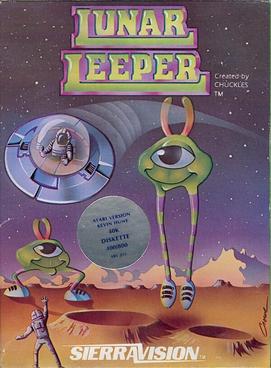
Lunar Leeper, also released as Lunar Leepers, is a horizontally scrolling shooter written by Chuck Bueche and published under Sierra On-Line's SierraVision label in 1982. It was released for the Apple II, Atari 8-bit computers, Commodore 64, and VIC-20. The Apple II version was copy-protected using Sierra's Spiradisc system.
Spiradisc was a copy protection scheme used by Sierra On-Line on their floppy disk releases for the Apple II. The technique, developed by Mark Duchaineau, involved writing the data on spiralling paths on the disk rather than in concentric circles. Initially, no commercial copying software or bit nibbler could successfully copy the disks it was applied to.

Where in Europe Is Carmen Sandiego? is a 1988 European geography-based educational computer game in the Carmen Sandiego detective mystery franchise. It was originally published by Broderbund in 1988 for Apple II, Commodore 64, and DOS, and ported to the Amiga and Macintosh in 1989. It is the third Carmen Sandiego title, after Where in the World Is Carmen Sandiego? (1985) and Where in the USA Is Carmen Sandiego? (1986). Under the guidance of The Acme Agency's chief, the player completes cases to catch Carmen's henchmen; they accomplish this by traveling to European cities to find clues relating to the crook's last known whereabouts, and by gaining enough character data to issue a warrant of arrest. Once the player has captured all 15 thieves, they can pursue Carmen herself.

Learning with FuzzyWOMP is an educational math game aimed at preschoolers. It was published by Sierra On-Line in 1984 for the Apple II. The game is similar to Learning with Leeper (1983).
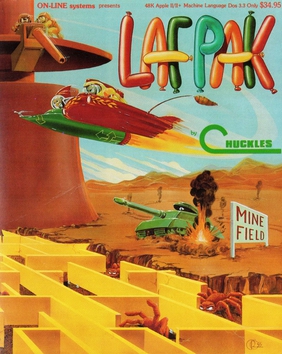
Laf Pak is an Apple II video game developed by Chuck Bueche and published by Sierra On-Line in 1982. Laf Pak is a compilation of four action games: Creepy Corridors, Mine Sweep, Apple Zap, and Space Race.

Math Blaster! is a 1983 educational video game, and the first entry in the "Math Blaster" series within the Blaster Learning System created by Davidson & Associates. The game was developed by former educator Jan Davidson. It would be revised and ported to newer hardware and operating systems, with enhanced versions rebranded as Math Blaster Plus! (1987), followed by New Math Blaster Plus! (1990). A full redesign was done in 1993 as Math Blaster Episode I: In Search of Spot and again in 1996 as Mega Math Blaster.

Donald's Alphabet Chase is a educational video game developed by Westwood Associates and published in 1988 by Walt Disney Computer Software. It was released on various home computers including the Amiga, Amstrad CPC, Apple II, Commodore 64, MS-DOS and ZX Spectrum. An Atari ST version was planned by Nathan Software but got no release. The game was released in five different languages including English, Spanish, French, Italian and German.
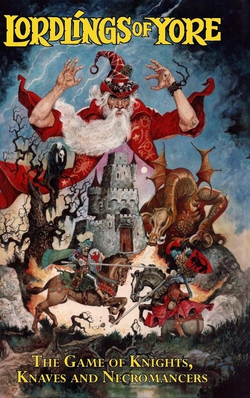
Lordlings of Yore is an Apple II video game published by Softlore Corporation in 1983.















